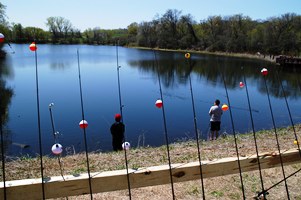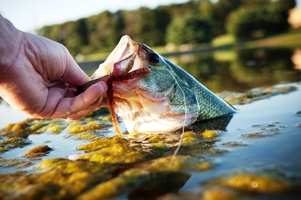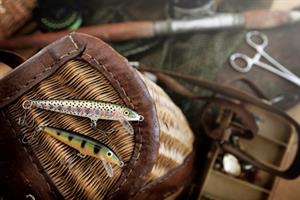In 1969, two momentous events occurred in my life — and both had to do with fishing. The first was getting my driver’s license. I desperately wanted a license, not so I could date girls (they didn’t know I was alive) but so I could explore nearby fishing hot spots. The second was putting together a new tackle box. I had saved my money and stuffed that tackle box with classic lures (and some on their way to becoming classics), including Rapala® Original Floating® minnows, Creme Scoundrel worms, and Mepps® Aglia® spinners.
These artificials continue to be prized by American anglers today. In fact, many of the lures I bought back in 1969 are still in my tackle box (and still help me hook a fish or two). This got me to thinking about lures that have “stood the test of time” — designs so successful that they are as popular today as when they were introduced.
Early Clunkers
If we could be magically transported back to 1922, the year the Izaak Walton League was founded, we would barely recognize the way fishermen went about their pastime — especially their use of lures. “In the 1920s, the economy was good and fishermen seemed content to go about their sport as they had always done,” says Jim Martinsen, spokesman for Mepps. “Most lures were of the ‘match the hatch’ variety. They were wooden representations of baitfish and crawfish — things fish ate. However, many of these lures didn’t move or act like live creatures.”
The rods were just as clunky and stiff as the lures and usually made from metal, explains Martinsen. Even his dad fished with a telescoping metal rod, which, like others of the time, was a baitcaster. Line was typically a heavy, black braid.
Despite the clunky fishing poles and lifeless lures, many popular lures from the 1920s were outstanding fish catchers. The Creek Chub Pikie Minnow, Heddon Dowagiac Wooden Minnow, and the South Bend Bass-Oreno certainly fit that category. However, the only place to find most of these lures today is on E-Bay rather than tackle shop shelves. That’s because the angling world — and the world at large — changed dramatically in the 1930s and 1940s.
The Wiggle Fish Can’t Resist
Those early lures “often looked anatomically correct, but their actions weren’t realistic,” explains Mark Fisher, director of field promotions for Rapala. “Lures were made to look like every conceivable thing that a fish would eat, but the flash, the vibrations, the triggering mechanisms that cause a fish to hit a lure were largely lacking.” When the Great Depression hit, people around the world “weren’t fishing for sport but for survival,” Fisher says, “which led to a lot of innovation.”
 Among those fishing for survival was Finnish angler Lauri Rapala. While paddling around Lake Päijänne, the second largest lake in Finland, Rapala had an epiphany: Big fish eat little fish, specifically little fish that are injured or stand out from a school in some way. In 1936, Rapala created the prototype for what became one the world’s most famous lures — the Original Floating® Rapala Minnow.
Among those fishing for survival was Finnish angler Lauri Rapala. While paddling around Lake Päijänne, the second largest lake in Finland, Rapala had an epiphany: Big fish eat little fish, specifically little fish that are injured or stand out from a school in some way. In 1936, Rapala created the prototype for what became one the world’s most famous lures — the Original Floating® Rapala Minnow.
“Lauri hand carved his lure from pine bark, wrapped it in chocolate candy bar tinfoil to add flash, and then melted photographic negatives for the protective coating,” Fisher describes. Rapala even drew scales onto the foil by hand. “Later, he discovered that balsa wood was more buoyant and stronger, so the lures became made from that.”
No lure had ever so accurately mimicked a struggling, dying minnow. During the Depression, Rapala fed his family. During World War II, he fed Finnish troops. After the war ended, word of this new lure spread, and Rapala had to recruit family members and friends to craft enough lures to fill incoming orders.
Rapala’s steady growth took a giant leap in 1962, when Americans were transfixed by the details of Marilyn Monroe’s death. Life magazine featured Monroe on its August 1962 cover, and tucked inside that same issue was “A Lure Fish Can’t Pass Up” — an article about Lauri Rapala and his balsa minnow. It was Life’s biggest selling issue, and sales of the Rapala lure skyrocketed.
Today, the Rapala Original remains a fixture in American anglers’ tackle boxes. I caught pond largemouths on this minnow when I was a teenager and still rely on it today when I float for river smallmouths.
Lures Become Enticing
Just a few years after Lauri Rapala crafted his wobbling minnow, another artificial lure came on the scene that changed fishing forever. The Mepps Aglia spinner was created by French engineer Andre Meulnart. The Frenchman’s design was completely different from any at that time — it mirrored nothing in nature.
“The Mepps Aglia was one of the first ‘enticer’ lures,” says Jim Martinsen. “Let me explain what I mean by that. If you give a cat an unlimited amount of food, eventually it will walk away. But if you throw a ball of yarn across the floor, that same full cat will chase after that yarn. The flashing of a spinner’s blade has the same effect on fish as the yarn does on our fat cat.”
American GIs who served in World War II brought Mepps lures home, and the lure’s reputation grew — but it was almost impossible to find one in the United States. That is, until Wisconsin tackle-store owner Todd Sheldon began importing them from France. Sheldon discovered the Mepps spinner in 1951 when he decided to try out a lure a GI friend had given him two years earlier. It was an instant success on the river — and such a success in his store that Sheldon closed his tackle shop to focus solely on importing Mepps lures.
“One of the most amazing things to me is that more than 70 years later, the Aglia still accounts for more than 50 percent of our business,” Martinsen says. “When people talk about Mepps spinners, that’s usually what they mean.”
In clear water conditions, the Mepps Aglia remains a super fish catcher for panfish and trout. I once had a fellow angler try to bet me that he could catch 9 fish on 10 casts with a Mepps Aglia. I refused to take the bet because I considered the odds to be on my friend’s side. Perhaps I should have accepted the challenge. My buddy only caught eight fish — he lost fish on the other two casts.
Plastic Makes the Worm
Technological advances are often one result of war, and so it was with plastics in the 1940s. Softer, more moldable plastics developed during World War II were available for use in consumer products after the war. In 1949, Nick Creme devised an artificial that has become ubiquitous in bass anglers’ tackle boxes.
 Rubber worms had been in use for decades, but they were rigid, lifeless creations with a texture unattractive to game fish. Laboring in their Akron, Ohio, basement, Nick and Cosma Creme combined vinyl, oils, and pigments to produce a molded plastic worm that was far superior to previous rubber crawlers. “Nick Creme was a machinist by trade and he lived in the country’s rubber hub, where Goodyear and B.F. Goodrich had plants, so he had access to the plastic technology of the time,” says Wayne Kent, president of Creme Lure Company. “Nick often fished live nightcrawlers with a hook harness, and he knew that the rubber worms of the time moved and felt nothing like real worms. So it’s not surprising that the early plastic worms he created came with a hook harness and moved more like real nightcrawlers than anything that had come before.”
Rubber worms had been in use for decades, but they were rigid, lifeless creations with a texture unattractive to game fish. Laboring in their Akron, Ohio, basement, Nick and Cosma Creme combined vinyl, oils, and pigments to produce a molded plastic worm that was far superior to previous rubber crawlers. “Nick Creme was a machinist by trade and he lived in the country’s rubber hub, where Goodyear and B.F. Goodrich had plants, so he had access to the plastic technology of the time,” says Wayne Kent, president of Creme Lure Company. “Nick often fished live nightcrawlers with a hook harness, and he knew that the rubber worms of the time moved and felt nothing like real worms. So it’s not surprising that the early plastic worms he created came with a hook harness and moved more like real nightcrawlers than anything that had come before.”
The Creme Wiggle Worm (called the Scoundrel today) debuted in 1951 — $1.00 for a pack of five — and became an immediate hit with the angling public. Early worms had threehook harnesses threaded through them, similar to what live bait anglers were using. As demand continued to grow, Creme moved his business to Tyler, Texas — where largemouth bass fishing in newly made reservoirs had become the rage and demand for single replacement worms was growing. “When those lakes were created, bulldozers made pits where all the trees were piled up and where, of course, many of the bass congregated,” Kent says. “That situation helped lead to some unknown individual developing a weedless worm rig — the Texas rig — which today is the most commonly used bass fishing rig.” The bass anglers in Texas used their Creme worms to create this rig.
Like many folks who became of angling age in the 1950s and 1960s, the Creme Scoundrel was the first plastic worm I used to catch bass. The fact that this worm has been imitated by so many companies over the years is the ultimate testimony to how well it works.
A Flurry of New Lures
The 1960s ushered in several more classic lures. The Mepps Black Fury came with squirrel hair on the treble hook and with the offer that youngsters could turn in squirrel tails for lures or money. The news about the Black Fury and the tail offer swept through the elementary school I attended at the time, and many of my peers boasted that they could buy untold numbers of lures with the money earned from turning in gray squirrel tails. Mepps still “recycles” squirrel tails today, and you can still trade in those tails for lures or cash.
The first “alphabet” crankbait was also created in the 1960s. That’s when Fred Young carved the first Big “O” lure — named after his brother Odis — from a block of balsa wood. In 1973, manufacturer Cotton Cordell® decided to make the lure from hard plastic rather than wood — and sold 1.3 million lures the first year.
The Big “O” helped spawn an upsurge in crankbait use that continues today. PRADCO (Plastic Research and Development Corporation), perhaps the largest hard-plastic fishing company in the United States, now owns Cotton Cordell and continues to produce this timeless lure.
The Cordell Big “O” was the first crankbait I ever bought and remains my favorite crank for river smallmouths. I once witnessed a fellow angler climb a tree alongside a creek to retrieve a particularly productive Big “O” that he had tossed into the branches.
Making a Comeback
Just as some lures become classics, others fall in and out of favor — regardless of how well they work. One such lure is the Knight Lit’l Fishie, (basically a soft plastic minnow impaled on a jig hook), which was introduced in 1980. During the early 1980s, I remember fishing Virginia’s justopened Lake Moomaw, and it seemed everyone was employing the Lit’l Fishie for bass. I have not seen anyone tie on this bait for many years.
“The Lit’l Fishie is a perfect example of a lure that still catches fish but no one talks about anymore,” says Creme’s Wayne Kent. “This bait is so simple to fish — all you do is cast it out and retrieve it at a moderate speed — that anybody can catch fish with it.”
 The Rebel Pop-R lure came out in 1976 but disappeared just two years later from the company’s catalog and sporting goods stores’ shelves. However, one east Texas tackle shop continued to place special orders for the lure for a few tournament anglers. A magazine article in the early 1980s that labeled the Pop-R as the “secret bait of the pros” started a frenzied demand for this surface chugger, and the lure has remained a big seller ever since. Indeed, the Rebel Pop-R now is generally considered a classic lure, and it’s one of my two favorite topwater lures for river smallies (the other is the Heddon® Tiny Torpedo).
The Rebel Pop-R lure came out in 1976 but disappeared just two years later from the company’s catalog and sporting goods stores’ shelves. However, one east Texas tackle shop continued to place special orders for the lure for a few tournament anglers. A magazine article in the early 1980s that labeled the Pop-R as the “secret bait of the pros” started a frenzied demand for this surface chugger, and the lure has remained a big seller ever since. Indeed, the Rebel Pop-R now is generally considered a classic lure, and it’s one of my two favorite topwater lures for river smallies (the other is the Heddon® Tiny Torpedo).
One more lure from the 1980s bears mentioning: the Lunker City Slug-Go.™ I met the lure’s inventor, Herb Reed, at the 1987 Bassmaster Classic. Reed enthusiastically told me about a new type of lure that he had created (a soft plastic jerkbait) that to me looked like an elongated chunk of lifeless plastic. I silently dismissed the lure as not even worthy of a temporary fad and moved on to the next booth.
By the time of the next Classic, however, fishing the Slug-Go had become an obsession for bass anglers, and I had an assignment from a national magazine to profile Reed and his creation. Today, nearly every soft plastic company makes a jerkbait.
“The Slug-Go and other soft plastic jerkbaits are perfect examples of lures that don’t look like anything alive when they are inside a plastic bag but come alive in the water,” says Mark Fisher. “In that sense, they are the opposite of 1920s baits, which looked like fish prey but didn’t act like something alive.”
The New Classics
What will become the classic lures of this century?
“Faddish lures from the 20th century included baits that glowed in the dark and others that were motorized — and they all failed,” said Jim Martinsen. “Perhaps some future 21st century classic lure might be one that is holographic and moves in some unique way.”
Mark Fisher votes for the X-Rap,® another minnow imitation from Rapala, which can be fished in either a “slashbait” technique or with the classic Rapala wobble. I have been using this lure for the past several years and have enjoyed consistent success with it. Lawrence Taylor of PRADCO believes that one of the subsurface walk-the-dog style plugs may emerge as a classic or perhaps the Chatterbait, which is a hybrid spinnerbait, crankbait, and jig.
Whatever happens, we are not likely to return to the days of the 1920s, when game animals were used to catch sport fish. “Old timers back then would float a board that had a squirrel with a hook harness on top,” explains Mark Fisher. “When those fishermen felt that the board had floated out to where these huge northern pike were holding, they would jerk the board out from under the squirrel and let it swim about. Those guys caught some huge pike with that tactic.”
Fortunately, we have many more effective options today.
Support our work for outdoor recreation